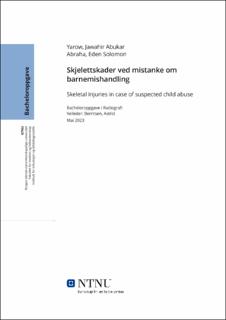| dc.contributor.advisor | Berntsen, Astrid | |
| dc.contributor.author | Yarow, Jawahir Abukar | |
| dc.contributor.author | Abraha, Eden Solomon | |
| dc.date.accessioned | 2023-07-11T17:20:59Z | |
| dc.date.available | 2023-07-11T17:20:59Z | |
| dc.date.issued | 2023 | |
| dc.identifier | no.ntnu:inspera:139584812:148961391 | |
| dc.identifier.uri | https://hdl.handle.net/11250/3077805 | |
| dc.description.abstract | Problemstilling: Hvilke skjelettskader bør radiografer ha kunnskap om ved mistanke om barnemishandling i konvensjonellrøntgen?
Hensikt: Hensikten med denne oppgaven er å finne skjelettskader ved barnemishandling, for å øke kunnskapen til radiografer, radiografstudenter og annet helsepersonell.
Metode: Det blir benyttet litteraturstudie som metode for å besvare problemstillingen. Søket er gjennomført i fire ulike databaser og ni studier danner grunnlaget for resultatene i oppgaven.
Resultat: Resultatene i oppgaven er bygd opp på forskningsartikler, hvor fokus er å finne frakturer som assosieres med mishandling. Frakturer som har høy spesifisitet for barnemishandling, inkluderer costafraktur og CML. I tillegg fraktur i rørknokler, kraniefraktur, hender og føtter, epifysiolysefraktur og vertebral fraktur gir mistanke om mishandling.
Konklusjon: For å kunne identifisere fysiske mishandling hos barn kreves nøye vurdering av frakturtyper, skademekanismen, historien til skaden, barns alder og utviklingsstadium.
Noen frakturer har høyere spesifisitet for mishandling enn andre, derfor for å utelukke mulig mishandling hos barn bør alle disse faktorer tas i betraktning.
Nøkkeldord/søkeord: barnemishandling, skjelettskader, fraktur, radiografi
Antall ord: 7506 | |
| dc.description.abstract | Topic/ Research question: Which fractures should radiographers be aware of when suspecting child abuse in conventional X-rays?
Purpose: The purpose of this study is to find fractures caused by child abuse in order
to increase the knowledge of radiographers, radiographer students and other healthcare professionals.
Method: A literature review is used as a method to answer the research question. The search was conducted in four different databases and nine studies form the basis for the results in the thesis.
Results: The results in the thesis are based on research articles, where the focus is on finding fractures that are associated with abuse. Fractures that have high specificity for child abuse include costa fracture and CML. In addition, fractures in the long bone, skull fractures, hands and feet, epiphysiolysis fractures and vertebral fractures raise suspicions of abuse.
Conclusion: To be able to identify physical abuse in children it requires careful assessment of fracture types, the mechanism of injury, the history of the injury, the child's age and stage of development. Some fractures have a higher specificity for abuse than others, therefore to rule out possible abuse in children all these factors should be taken into consideration.
Keywords: child abuse, skeletal injuries, fractures, radiography
Number of words: 7506 | |
| dc.language | nob | |
| dc.publisher | NTNU | |
| dc.title | Skjelettskader ved mistanke om barnemishandling | |
| dc.type | Bachelor thesis | |
